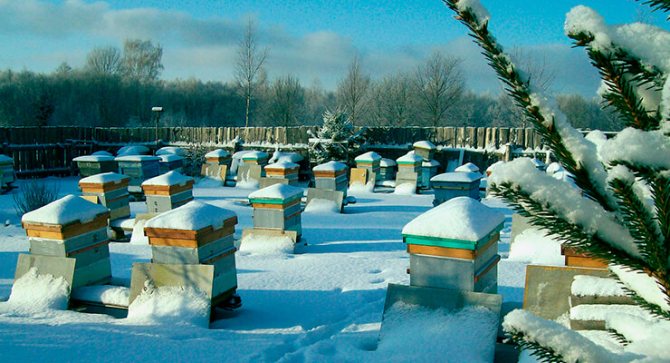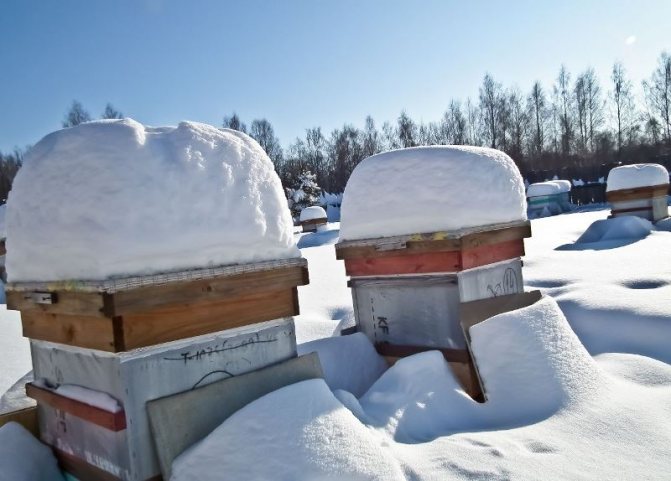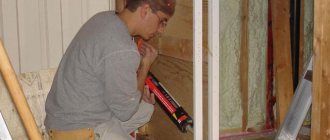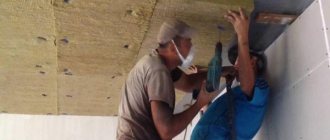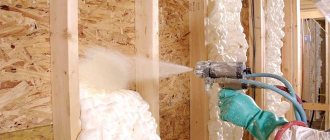The essence of the method
A logical question arises: how do bees hibernate on the street and do not freeze? Nature has thought over and arranged everything in such a way that the bees manage to survive and accumulate enough energy for spring outings. The trick lies in the fact that the bee colony is a well-coordinated mechanism, each "screw" of which performs certain functions.
As soon as the cold sets in, the family huddles into a winter club. Young growth concentrates inside it, generating heat. The old bees, in turn, form an insulating layer to maintain the optimum temperature inside the club. Now do you understand how bees winter on the street without additional insulation?
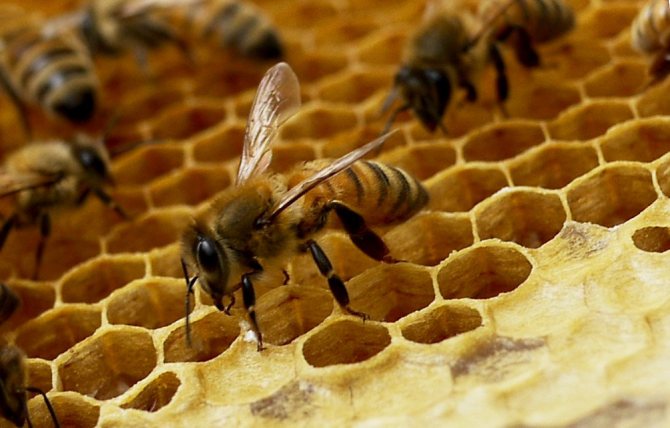
It turns out that nature has created all the conditions for wintering bees in the wild. Insects nestle tightly against each other and thereby protect the uterus and young animals. It is worth noting that it is in winter that the uterus lays eggs and lays the foundation for extending the life of the family. With the onset of warmth, bees begin to fly regularly, gradually moving away from winter passivity.
Features of wintering bees on the street
Before answering the main question, let's get back to the origins. Striped workers appeared on Earth several million years ago. Naturally, there were no people then and no one could tame insects. Scientists have found that the bees hibernated in the hollows of trees. From this we can conclude that, according to the idea of nature, insects are able to maintain a population even in the most severe conditions. This explains the fact that several thousand years ago our ancestors collected wild honey in central Russia and the Urals.
It turns out that hives for wintering can be freely installed outside. Bees are able to safely survive the cold and delight their owners with delicious honey.
Rules and conditions for wintering bees on the street
- It is important to carefully control the stocks of food, if necessary, prepare top dressing for the successful wintering of insects on the street.
- Only strong families can survive the winter, therefore the weak can die during the cold season.
- If necessary, it is advisable to join a weak family to a strong one, so the chance of its survival increases.
- It is necessary to exclude the influence of external irritating factors so that the houses are quiet.
How much honey to leave bees for the winter
Hive revision before wintering
What should be the preparation of bees for winter, the video at the end of the article tells in detail. An important question: how much honey should they leave? Please note that this stock must be the highest qualityso that it contains a huge amount of nutrients. In no case should honeydew honey be used, as it promotes the formation of poorly digestible substances in the stomach of individuals. And this is fraught with death. To check the quality of the product, experienced beekeepers carry out a lime reaction. To do this, 1 liter of quicklime is placed in a 2-liter container. After that, purified water is poured. Then, when the mixture has settled, it is poured into the honey mass mixed with water. In the event that flakes appear, the honey is considered to be of poor quality. When wintering in outdoor conditions, you need to leave at least 30 liters of honey, 20-22 are enough for a room.
How to choose a wintering place for bees
With the onset of winter, the bulk of insects fall into a state of dormancy, which is undesirable to disturb. In order to wait out the cold, they have been stocking up with honey and pollen since summer.They store all supplies in combs, which gives them the opportunity to winter safely and, with the onset of warmth, lead a more active life, get food and raise the younger generation.
Wintering of bees is carried out in two ways: either in the wild, or in a special hive for wintering.
Today, the wintering of bees in the wild is not very popular among beekeepers, although this method is customary for insects and in hives it is sometimes more difficult for them due to the likelihood of a lack of food or high humidity and dampness.
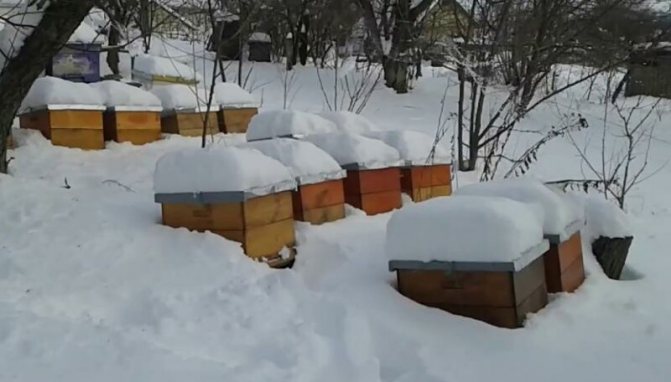

Monitoring the state of the hive


In order to find out how the charges are feeling, it is not necessary to open the hive - it is enough to put a pipe on it and listen to what is going on there.
If a moderate, uniform hum is heard from within, then the family is in full health. Faint rustling or intermittent sounds indicate the trouble of the colony. With the onset of the first warm days, it is necessary to remove the snow and disassemble the huts - they will turn out to be an obstacle for insects getting out for the first flight.
Preparing families for wintering
It is necessary to build up the mass of young, healthy, unemployed workers. Old individuals are not needed for wintering bees: they will not survive until spring anyway. Only honey is used in vain for their content.
- We calculate the time until which the uterus should lay eggs. We subtract a month from the date of the last flight in your area. So that the freshly hatched bees have time to fly around before wintering.
- Until that time, we stimulate egg-laying with stimulating feeding (in the absence of a bribe). When maintaining an apiary, we replace queens annually or after a year: young worms take longer.
- We carry out therapeutic measures. We treat it twice for varroatosis, with which, alas, all apiaries are now infected. The first time - at the end of the main bribe: without reducing the number of parasites, it is impossible to raise full-fledged workers. The second time - after the emergence of the entire brood: in its absence, the efficiency of any processing is maximum, the entire mite is in the nest. If the apiary is infected with other diseases, we treat it. Before the formation of the club, it is good to give medicinal feeding to prevent nosematosis. A good wintering of bees is impossible if we have sick, mite-sucked insects!
- We try to keep older workers busy with sugar syrup processing, drying and repairing damaged frames. To do this, we give all the syrup fed in large doses immediately after the main bribe.
- If it's a good day for flying around, and the insects are already in the club, you can try to induce them to fly out by knocking, noise, and partial parsing of the nest. The later they fly around, the less fecal load on the hibernation of bees.
We allocate spare queens to small families. There is usually enough time to form cores after the main flow to the mature mother. The queens will fly around and have time to grow enough young individuals for a good wintering of the bees. Such families are inexpensive in terms of cost: there are enough workers and queen cells at this time, with minimal efforts of the beekeeper. Keeping 10% of spare queens from the number of families in the apiary helps to save the lost queen from death. Or develop it into a full-fledged unit next season, as in the video.
We begin preparing for wintering immediately after the main flow, simultaneously with the selection of honey. Even then, sorting through the frames, we leave brood and low honey brown (I prefer their queens in spring), form cores for spare queens, clean the folds, prepare and distribute sugar syrup. We carry out therapeutic measures.
Preparing hives for wintering
To keep the bee hive warm even in severe frosts, the wooden house in which the bees are kept should be carefully insulated. It is usually recommended to do insulation on the sides and bottom with polystyrene foam, pieces of roofing felts, burlap, any dense materials. The main thing is that there are no gaps. It is recommended to raise the house in autumn above the ground by placing it on high, stable wooden pegs.
With the onset of a long-term severe cold snap, experienced beekeepers advise to dig a house around the edges with snow, but it should not be allowed to come into contact with the walls. The most destructive thing when bees overwinter outdoors is high humidity. If snow gets into the tray, it will melt inside, this is contraindicated. Already in February, you need to dig out the house and shovel the snow away.
Be sure to leave small holes in the house for ventilation and airing. However, before that, it is worth checking that autumn rain and snow do not fall into holes or crevices. It is necessary to ensure that the branches of trees, shrubs do not touch the walls in the wind, this will disturb the hive. You will also have to drive away annoying crows and magpies from the apiary - they are too noisy.
When bees hibernate on the street, the correct formation of the club and the hive is extremely important: in severe frosts, an incorrectly located club perishes from hunger with sufficient feed reserves. The point is its low mobility.
Normally, it forms in the lower part of the middle (when viewed from above) of the nest, a little closer to the tap hole. During the winter, it slowly rises on the honeycomb warmed up by the warm air above the club. Bees in easy motion: like penguins, they alternate on the cold edge, some of them crawl into the vacated cells for compactness.
When keeping an apiary in multi-hulls, the device of the hive during the wintering of bees requires overcoming a small "honey-free" barrier between the frames of the two hives. And if they encounter a large space of the left low-honey frame during the wintering of bees on the street and in severe frosts, they will not be able to overcome it. And they will die of hunger, regardless of the presence of any reserves of honey behind the "barrier". Here is a video of the club's location in October.
Therefore, we try to leave only frames filled with bee food at least 2/3.
We arrange full-fledged ones alternately with less filled ones. The brood should be at the bottom, this is where the club will be formed. It is better to remove the ceiling pillow, then it will fit exactly on the bottom. Back in the nest when the cold weather sets in. Yes, for the winter, the insulation must be dried, the pillows, preferably unpolished. It's all about physics: if you insulate the nest too much and limit ventilation, the dew point will fall on the inside of the nest.
Condensed water - dampness in the nest, fermented honey, as a result of diarrhea and death during the wintering of bees in the wild.
It is not necessary as a heater to chase padding polyester, cotton wool and other highly effective materials with a low heating coefficient. Wood shavings in a pillow made of cheap fabric are just that. Warming hives for the winter should not be excessive! Hibernation of bees outside implies a strong temperature difference in the nest and outside. Having overdone, we will achieve condensation of moisture from the air exhaled by wintering insects in the hive. With inevitable dampness and accompanying troubles: the wintering of bees will be bad, lucky if they don't die ...
We look through the hives so that there are no cracks. We put entrance barriers from mice. In autumn, we keep bees with reduced entrances: apart from keeping warm, small openings are easier for bees to guard. And then wasps and other "honey-loving" insects like to enter the nest when it gets cold: bees are inactive and guard the entrances poorly. The device of the hive, where the lower entrance is at the level of the bottom, carries an additional danger.
The lower notch can be clogged with submergence. If necessary, clean the notch with bent wire during hibernation. Better yet, insert an extra stretcher when preparing for it. When maintaining an apiary at any time, it is worth correlating the size of the entrance to the strength of the family, but especially in the fall and in the period without tipping. When keeping bees, beekeepers often notice subtle imperfections and manually make improvements to the insect house.In this video, the beekeeper, while keeping the family in the Beebox hive, showed the correction of some of his shortcomings.
It is good to cover the entrances from the wind and the sun with shields from the material at hand. The sun during a thaw can induce oviposition too early in the uterus, especially in southern breeds. The wind blowing into the notch - fast and strong cooling of the nest. In addition, birds can disturb the bees by tapping with their beak near the nest. And pecking at the crawled out insects. Wintering of bees in polystyrene polystyrene hives is often easier than wooden hives.
When kept in them, there is a plus: expanded polystyrene hives keep heat better. But they are too light. It is advisable to put a brick on the roof of expanded polystyrene hives, not for the winter, but for the whole season. For protection from strong winds. You can make expanded polystyrene dividing boards. Sometimes they are more convenient than insulating pillows when supporting families: they are easily placed in the right place. With a small volume, it protects well from the cold.
Insulation of the hive
When bees hibernate in the wild, the beekeeper is limited in its control and assistance to families, so "little things" should not be missed. There are no trifles, everything is important. Families in multi-body hives should winter in 2 buildings, even weak ones: the height of the Rut frame is not enough for high-quality wintering of bees.
It is easier for the club to move upwards than to the side!
Weak colonies and spare queens can be placed two in one hive with a blank partition between them. The hives standing on high stands should be lowered, but not on the ground, but on low stands, for example, bricks laid flat in 1 row. Another way to keep spare queens in multi-body hives: we put the nucleus in the upper, additional body. Having nailed down the false bottom, the partition must be solid! External insulation of the hive with snow is suitable if the winter in your area is long and without thaws. For such a warming of the hive for the winter, we cover it with spruce branches, wrap it with a material that passes through steam (not with tar), then sprinkle it. No knocking: any excitement for wintering insects is harmful.
Advantages and disadvantages of the method
Benefits:
- Lack of large investments.
- No need to transport hives during the first spring and cleaning flights. By the way, the latter are more and more often recorded in the midst of winter due to unstable temperature conditions outside.
- Earlier development of bee colonies. Wintering inside a hive located on the street is more active than in Omshanik, so in the spring, families that winter on the street are also more active and productive. It has been noticed that bees in the spring, after wintering on the street, often clean up the dead soil themselves.
Among the disadvantages of wintering on the street are:
- Plenty of honey and sugar syrup for feeding - frames should be sealed at least 2/3 of the height.
- Difficulties with placing hives in a non-solar, protected from wind and precipitation area
- The need to think over protection from birds that can gouge the hives, spoiling them, and at the same time luring the bees in order to further devour them.
- The need to monitor changes in weather conditions, snow cleaning, if necessary, rearrange the hives.


Checking bees and inspecting their winter ball
The main rules for examining a ball of insects:
- the houses should be installed so that even during the period of heavy snowfall it is possible to move freely between the hives without touching them with clothes;
- the covers are removed in calm weather, trying not to make noise;
- try to carry out the inspection in cloudy weather, since they are sunny
Providing bees outside with food
Bees in hives, whose food reserves are about 25 kilograms or more, hibernate outside without additional feeding. To fulfill this condition, they should be taken out in the fall for late honey harvests, making sure that the insects do not weaken. Proper maintenance of bee colonies in winter requires the presence in each house of 2-3 frames with stocks of bee bread, several frames with honey. If there is not enough feed, the families will have to be supplemented with sugar syrup or sugar-honey mixture.
Why bees die in winter in hives
The bee plague is influenced by various circumstances:
- weak families;
- loss of the uterus;
- high temperature and humidity;
- hunger and diarrhea;
- diseases;
- pests.
Excess moisture is the cause of mold. Consequently, the Omshanik is poorly ventilated. Excess moisture leads to sourness of honey, which bees cannot eat. The pad quickly crystallizes and turns sour; such food is not suitable in the winter. As a result, insects will die of hunger.
If the bees have not made the last flight in the fall to empty their intestines, a lot of feces will accumulate. This also leads to death.
The absence of a mother is the cause of the pestilence. Insects begin to look for the uterus, a cube is scattered. The bees cannot re-assemble into a ball and die out.
Infectious diseases lead to the pestilence:
- salmonellosis;
- paralysis;
- lime brood;
- rotting of larvae.
For this purpose, a special treatment is carried out in the fall to eliminate pathogens.
Wintering methods
Wintering is an important period in the life of bee colonies, since the future of the entire apiary and the harvest depends on it.
There are several ways of wintering:
- in a special house called Omshanik;
- in the wild;
- in a pre-insulated room, namely in a bathhouse, basement, shed or greenhouse.
The beekeeper starts preparing for this event in advance.
It is important to check all the houses so that they are free of dampness and rot, various infections. On condition of preliminary preparation, the winter period passes without the death of families.
At this time, it is necessary to maintain a stable humidity and air temperature, to ensure good ventilation. Activities are performed before the onset of frost and cold weather.
Outdoor wintering


With the onset of cold weather, the bees form a winter club. This is necessary to save power and maintain a certain temperature.
The variant of wintering insects outdoors under the snow is used by beekeepers with extensive experience. It is required to eliminate all cracks by insulating in the fall and covering the hives with snow.
First you should check if the houses are well protected from the wind. Trees and other structures can be shields. It is possible to insulate the walls with slate or roofing felt.
Wintering of bees in Omshanik
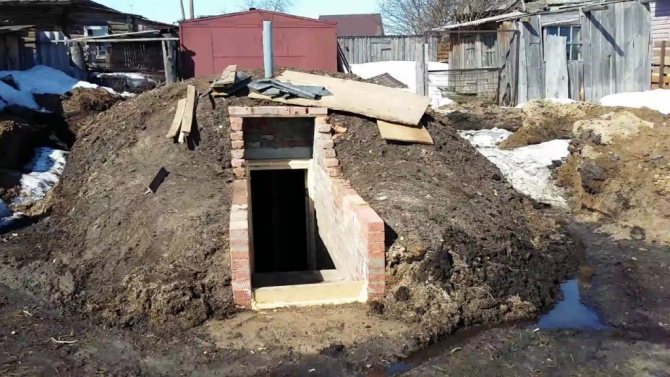

The site chosen for the building must be dry and protected from the wind. Mice should not enter omshanik; noise and light should be excluded.
Distinguish between aboveground buildings, underground and semi-underground. The most popular are underground. The hives are hidden to a depth equal to the height of the walls. In winter, they will have a stable temperature, and in spring it will be reduced, which is necessary for the successful completion of wintering. Omshanik walls should be rubble or brick, wooden ones often deteriorate with fungus.
Indoors
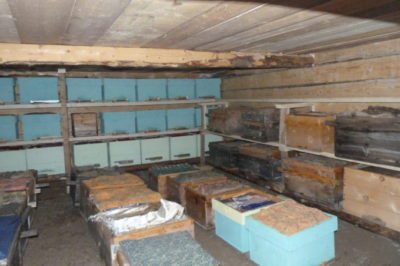

Some beekeepers set up huts with bees in a spacious shed. Wintering in a barn requires special preparation and wall insulation. The floor should be covered with a thick layer of sand, straw and dry leaves and branches. The wall must be protected from snow, rain, winds. To do this, you can fence it with slate or boards.
Beehives are installed in one row on boards or ground, with entrances to the exit. Make sure that the work with the entrances is done correctly. If there are gaps in the walls, they are carefully sealed so that rodents and bright light do not penetrate inside. The holes are closed with a dense mesh. Pine cones can be used if desired. An important condition is that it must be dry, warm and quiet inside. The top of the house for insulation is covered with spruce branches, straw, leaves, needles.
How bees winter on the street directly in Western Siberia
As noted earlier, in a properly prepared hive, bees overwinter well in Siberian frosts, even in the open air.
In this region, the main task of the beekeeper is to reliably protect insect habitats from drafts, and a similar phenomenon is quite frequent here.
It is also necessary to protect the hives from the invasion of rodents - they often choose them for arranging the nest.
High-quality insulation is required by insects belonging to thermophilic species, while the Central Russian varieties feel good even without special protection.
The most convenient way is to throw snow. A snowdrift is applied at the very beginning of winter. Its thickness is at least 0.7 meters. There is no need to tamp it especially, because air must also get inside. After this, insects should not be disturbed.

